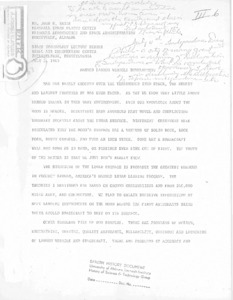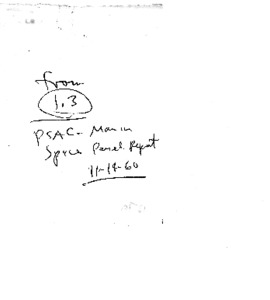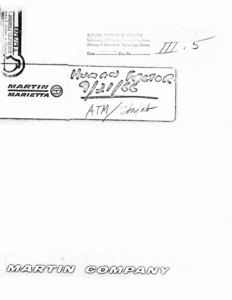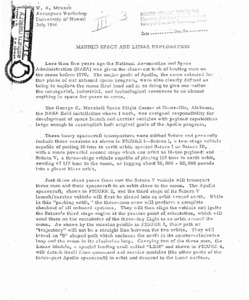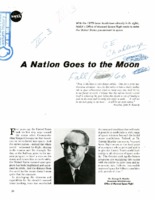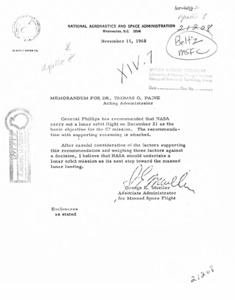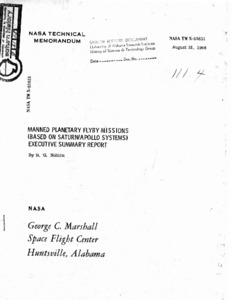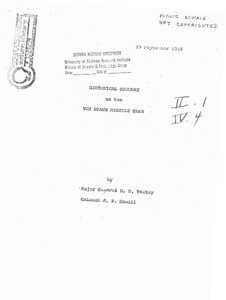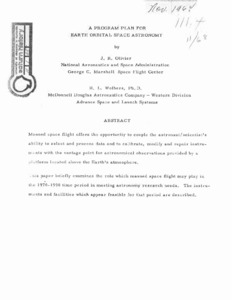
Browse Items (33 total)
Sort by:
-
"Saturn V America's moon rocket."
Diagram that displays the Saturn V rocket with a page beneath detailing the function of each stage. -
"Manned Launch Vehicle Development."
Includes handwritten notes. Includes references to slides. Essay remarking on how space vehicles will interact on the moon's surface. -
"Letter to Professor John Logsdon."
Letter to Professor Logsdon from Donald F. Hornig granting Logsdon's request PSAC Men-In-Space panel report. -
"Human Factor: ATM /Skylab."
Statement of work: Man/Machine activities -ATM; ATM problem areas; EVA commuting problem; Other EVA considerations; Analysis of crew considerations Mission 211/212; Mission objectives Crew Considerations; Mission Fight Profile & Operations Crew Considerations; Experiment operations crew considerations; EVA equipment requirements; Crew considerations carrier recommendations; Conclusions and recommendations crew considerations; Crew operations requirements preliminary 10 August 1996; ATM stabilization and control; ATM Carrier habitability and profile; Other ATM man/machine considerations.; Original is a poor photocopy.; Document has no page numbering. -
"Manned space and lunar exploration."
Paper includes references to figures and NASA's fundamental goals and principles. -
"A Nation Goes to the Moon."
Written by NASA Office of Manned Space Flight Associate Administrator George E. Mueller, this is an article from G. E. Challenge, Fall 1966, page 26 to 32. -
"Memorandum for Dr. Thomas O. Paine, Acting Director from George E. Mueller, Associate Administrator for Manned Space Flight, dated November 11, 1968."
Memorandum containing a recommendation from General Phillips to continue with the lunar orbit flight scheduled for December. -
"Manned planetary flyby missions (based on Saturn/Apollo Systems) : executive summary report."
This report summarizes a study (by North American Aviation, Space Division) of Manned Interplanetary Flyby Missions to Venus and Mars during the period from 1975 to 1982. [The study was a broad but penetrating technical investigation of using a manned flight system for planetary exploration.] The results, along with previously known aspects of manned Mars and Venus flyby missions, vehicles, and systems, were integrated into total mission-system capable of performing a realistic and meaningful planetary exploration program. Manned Planetary Missions are feasible. Attractive multiplanet flyby missions can be performed by Saturn/Apollo systems. However, injected payload and mission requirements developed within the guidelines and assumptions of this study cannot be met with modified S-II or S-IV stages when used with the standard Saturn V Earth-launch vehicle. When using an Earth orbit assembly mode and an uprated Saturn Earth launch vehicle for application to manned planetary flyby missions, the launch vehicle should have a payload capability (2-stage to low Earth orbit) of 400,000 pounds or more for use with M(S)-IVB planetary injection stages. Manned planetary flyby missions provide a means of combining the favorable aspects of both manned and unmanned missions into a unique and highly effective planetary exploration mission-system capable of providing major significant inputs to the scientific and engineering questions concerning the interplanetary medium, our Sun, and our neighboring planets Venus and Mars. -
"Historical Summary: S & ID Apollo Program."
Four and a half years have passed since President Kennedy and the United States Congress established a national goal of landing a man on the moon, before the end of the decade. This brief history is designed to be a working tool for use during the second half of this great adventure. It is expected that by presenting the events of the past in perspective this document will become a handy reference to accomplishments of the first half of the program. It is hoped that this volume will be of value to those directly and indirectly concerned with North American's portion of the Apollo program. This history contains a chronology of significant events, as well as material on the management of the program, a record of some of the breakthroughs in technology, a report of the hardware produced to date, and the many tests performed to man-rate the equipment. -
"A Program plan for earth orbital space astronomy."
Manned space flight offers the opportunity to couple the astronaut/scientist's ability to select and process data and to calibrate, modify and repair instruments with the vantage point for astronomical observations provided by a platform located above the Earth's atmosphere. This paper briefly examines the role which manned space flight may play in the 1970-1990 time period in meeting astronomy research needs. The instruments and facilities which appear feasible for that period are described.; Paper presented by J. R. Olivier, National Aeronautics and Space Administration, George C. Marshall Space Flight Center and H. L. Wolbers, Ph.D, McDonnell Douglas Astronautics Company - Western Division, Advance Space and Launch Systems.

